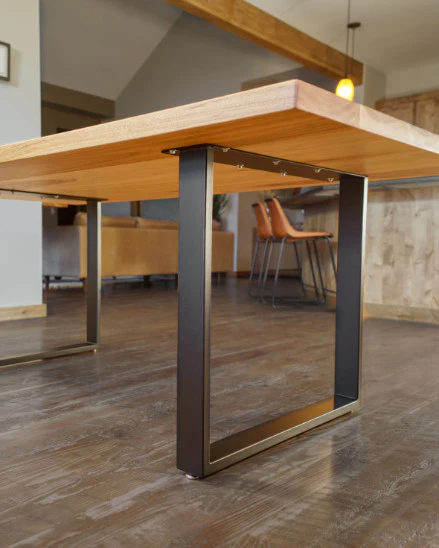A Thorough Take A Look At Table Leg Styles: Discovering the Perfect Suit
Selecting the right dining table leg style is critical for both visual charm and useful capability. For those with bigger tables, trestle legs make certain sturdy support, whereas barrette legs introduce a mid-century contemporary vibe with their minimalist design. The x-shaped legs blend contemporary style with enhanced security.
Conventional Four Legs
Amongst the numerous kinds of dining table leg designs, the conventional four-leg style remains an ageless choice for many households. 4 legs give balanced support, guaranteeing the table remains stable and capable of birthing significant weight (dining room table legs).
From a visual point of view, the conventional four-leg design can be easily adjusted to different interior designs. Whether crafted from wood, steel, or a mix of materials, these legs can be elaborately sculpted, smooth and minimalistic, or anything in between. Their adaptability permits them to match both rustic and contemporary settings effortlessly.
Furthermore, the straightforward structure of the four-leg layout helps with simplicity of activity and positioning within a room. Unlike even more complex bases, this style minimizes obstructions, supplying adequate legroom for diners. In summary, the standard four-leg table leg style weds sustaining sophistication with useful performance, making it an astute option for those looking for both type and function in their dining furniture.
Stand Base
Frequently commemorated for its classy and space-efficient layout, the stand base is a recognized option to the typical four-leg arrangement in eating table leg styles. Without edge legs, restaurants are paid for higher liberty of activity, making it a perfect selection for round and oval tables that advertise more intimate and comprehensive gatherings.
The main column itself uses a canvas for complex designs and imaginative expressions, including an element of aesthetic passion under the table. In recap, the pedestal base integrates performance with style, making it a refined and functional option for diverse dining atmospheres.
Trestle Legs
Trestle legs give a durable and timeless structure for dining tables, characterized by their horizontal cross-bracing and durable support light beams. Originating from medieval times, this layout has advanced yet retained its essential structure, making it a perennial fave in both typical and modern setups. The main trestle beam, typically supported by 2 or even more upright posts, uses extraordinary security, enabling for bigger table sizes without the demand for added legs.
A substantial advantage of trestle leg tables is the adequate legroom they supply. Unlike tables with four edge legs, the absence of obstructions at the table's edges supplies unobstructed space for chairs and restaurants, boosting comfort and availability. This makes trestle tables optimal for suiting larger celebrations, whether in an eating room or a reception hall.
The aesthetic adaptability of trestle legs is noteworthy. Offered in a range of products such as wood, steel, and composite, they can be completed to enhance a wide variety of indoor designs. From rustic farmhouse to sleek modern-day designs, trestle legs can be tailored to fit private preferences. Their enduring appeal and practical benefits make trestle legs a compelling choice for those seeking both style and usefulness in their dining table.
Barrette Legs

The charm of barrette legs exists in their simplicity and versatility - dining room table legs. Available in an array of materials, including steel and brass, they can be completed in numerous shades to complement different interior designs. Whether coupled with a rustic wooden tabletop or a modern glass surface area, hairpin legs easily blend click here for more functionality with a touch of vintage appeal
Toughness is an additional remarkable feature of barrette legs. In spite of their fragile look, these legs are engineered to bear considerable weight, making certain the table remains steady and protected. In addition, they are fairly very easy to set up, making them a preferred option for DIY enthusiasts and specialist furniture manufacturers alike.
X-Shaped Legs

Built from materials such as why not look here steel, timber, or a mix of both, X-shaped legs can be customized to match numerous layout choices. Steel legs often offer a sleek and industrial feel, perfect for loft-style apartments and contemporary dining spaces.
Furthermore, the design behind X-shaped legs makes sure also weight distribution, decreasing the risk of wobbling and improving sturdiness. This makes them particularly fit for bigger eating tables that call for extra assistance. In essence, X-shaped legs mix functional design with modern aesthetic appeals, making them an ageless choice for diverse eating atmospheres.
Final Thought
A thorough understanding of eating table leg styles discloses the unique qualities and advantages of each style. Trestle legs make certain durable support for larger tables, and barrette legs introduce a mid-century modern-day aesthetic.